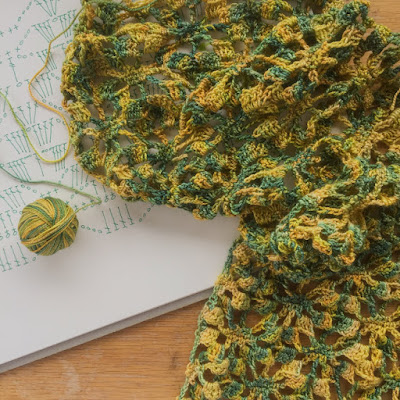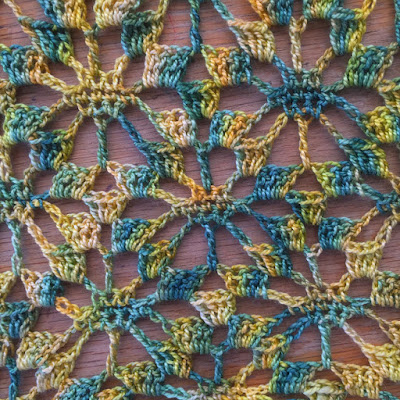Hello! As promised I am back with my 3rd pattern release in a row - this time my Cosy icicles Beanie! I designed this slouchie hat for
Crate Crochet, an australian crochet subscription box company, for their May 2017 box (timed for the southern hemisphere's winter). As well as being available in my
Ravelry Store to download as a FREE pdf, I am going to publish the pattern right here in this blog post ...
Cosy Icicles
Slouchy Beanie Hat Crochet Pattern
A two colour slouchy beanie hat, crocheted in the round using
a mix of double crochet stitches and spike stitches. I have
chosen Morris & Sons Empire for this design firstly because it
is soft and gentle against the skin and secondly because it
gives excellent stitch definition for the spike stitches. The hat
is worked from the brim to the crown and finished off elegantly
with a faux fur pompom.
This is an INTERMEDIATE level pattern, written in UK terms.
You will need ...
3 x 50g balls of Morris & Sons Empire, (a 10ply merino, 90m/ 50g) in the
following colours;
Kingfisher x2 (colour A) and Glass x1 (colour B)
faux fur pompom
thread for attaching pompom
5.5mm crochet hook
large needle for sewing in ends
sewing needle for attaching pompom
stitch marker or scrap yarn to keep track of rounds
You can buy Morris and Sons yarn here directly from their yarn store and it's
currently on sale!
Tension
17 stitches x 20 rows per 10cm (main pattern, in rounds)
Finished Size
Brim circumference; 54cm
Length (excluding pompom); 27cm
Abbreviations (UK terms)
ch chain
ss slip stitch
dc double crochet
dcSp double crochet spike (see notes)
dcBrim double crochet into brim (see notes)
dc2tog double crochet 2 stitches together
dec decrease
inc increase
cont continue
st stitch
beg beginning
rep repeat
Notes
The spike stitches in Round 3 (dcBrim) is worked right around the brim of the
hat; bring hook from front to the back under the brim of the hat: yarn over, pull
yarn up a loop to the height of the new round (2 loops on hook), insert hook
into dc stitch, yarn over, pull up a loop (3 loops on hook), yarn over, pull
through all 3 stitches. 1dcBrim made. Top tip: It is important to keep a very
even tension throughout this round to create a smooth effect on the brim, do
not attempt this section if you are stressed out or distracted!
Invisible decreases are an excellent way to decrease in crochet. In the pattern
where I have indicated dc2tog: insert hook through front loop only (flo) of 1st
stitch to be decreased (2 loops on hook), do not yarn over, insert hook through
flo of 2nd stitch to be decreased (3 loops on hook), yo, pull through 2 loops
(2 loops left on hook) yo, pull through both loops. 1 invisible decrease made.
If you are new to crochet and want to keep things simple, dc2tog in the standard
way. Here is a link to a blog post with a photo tutorial - it uses the US term single
crochet to describe the UK double crochet stitch but the photos are so clear this
should not matter. http://www.allaboutami.com/invisibledecrease/
It may help to have a stitch marker or contrasting length of wool to mark the
beginning of each round.
Top tip: when changing yarn colours there is no need to cut the yarn, simply
carry it up on the inside for when it’s next required, ensuring that it is neither too
tight, or too slack to keep the tension even. I do however recommend cutting
yarn B at the end of Round 21 before the larger block of colour, it’s a bit too long
to carry up.
Pattern
Using A, ch 81, ss into first ch to form large ring (top tip: make sure it is not twisted!)
Round 1 ch1, 1dc into next ch, 1dc in each ch across, ss into ch1 at beg of round (80dc)
Round 2 ch1, 1dc into each dc around, then changing to B, ss into ch1 at beg of round
Round 3 (cont B) ch1, *1dc in next dc, 1dcBrim working over next st and round brim* rep from * to * until end of round, ss into ch1 at beg of round
Round 4 ch1, 1dc into each dc around, ss into ch1 at beg of round
Round 5 ch1, 1dc into each dc around, then changing to A, ss into ch1 at beg of round
Round 6 (cont A) ch1, *1dc in next dc, 1dcSp in next dc in Round 4* rep from * to * until end of round, ss into ch1 at beg of round
Round 7 (inc) ch1, *1dc in each of next 3dc, 2dc in next dc* rep from * to * until end of round, ss into ch1 at beg of round (100dc)
Round 8 - 9 ch1, 1dc into each dc around, ss into ch1 at beg of round
Round 10 ch1, 1dc into each dc around, then changing to B, ss into ch1 at beg of round
Round 11 (cont B) ch1, *1dcSp in next dc in Round 9, 1dc in next dc* rep from * to * until end of round, ss into ch1 at beg of round
Round 12 ch1, 1dc into each dc around, ss into ch1 at beg of round
Round 13 ch1, 1dc into each dc around, then changing to A, ss into ch1 at beg of round
Round 14 (cont A) ch1, *1dc in next dc, 1dcSp in next dc in Round 12* rep from * to * until end of round, ss into ch1 at beg of round
Round 15 - 17 ch1, 1dc into each dc around, ss into ch1 at beg of round
Round 18 ch1, 1dc into each dc around, then changing to B, ss into ch1 at beg of round
Round 19 (cont B) ch1, *1dcSp in next dc in Round 17, 1dc in next dc* rep from * to * until end of Round, ss into ch1 at beg of round
Rounds 20 ch1, 1dc into each dc around, ss into ch1 at beg of round
Round 21 ch1, 1dc into each dc around, then changing to A, ss into ch1 at beg of round. Cut yarn B
Round 22 (cont A) ch1, *1dc in next dc, 1dcSp in next dc in Round 20* rep from * to * until end of round, ss into ch1 at beg of round
Rounds 23 - 35 ch1, 1dc into each dc around, ss into ch1 at beg of round
Round 36 ch1, 1dc into each dc around, then changing to B, ss into ch1 at beg of round
Round 37 (cont B) ch1, *1dcSp in next dc in Round 35, 1dc in next dc* rep from * to * until end of round, ss into ch1 at beg of round
Round 38 (dec) ch1, (1dc in each of next 8dc, dc2tog) 10 times, ss into ch1 at beg of round (90dc)
Round 39 ch1, 1dc into each dc around, ss into ch1 at beg of round
Round 40 (dec) ch1, (1dc in each of next 7dc, dc2tog) 10 times, ss into ch1 at beg of round (80dc)
Round 41 ch1, 1dc into each dc around, then changing to A, ss into ch1 at beg of
round
Round 42 (cont A) ch1, *1dc in next dc, 1dcSp in next dc in Round 40* rep from * to * until end of round, ss into ch1 at beg of round
Round 43 (dec) ch1, (1dc in each of next 6dc, dc2tog) 10 times, ss into ch1 at beg of round (70dc)
Round 44 ch1, 1dc into each dc around, ss into ch1 at beg of round
Round 45 (dec) ch1, (1dc in next 5dc, dc2tog) 10 times, ss into ch1 at beg of round (60dc)
Round 46 ch1, 1dc into each dc around, ss into ch1 at beg of round
Round 47 (dec) ch1, (1dc in next 4dc, dc2tog) 10 times, ss into ch1 at beg of round (50dc)
Round 48 (dec) ch1, (1dc in next 3dc, dc2tog) 10 times, ss into ch1 at beg of round (40dc)
Round 49 (dec) ch1, (1dc in next 2dc, dc2tog) 10 times, ss into ch1 at beg of round (30dc)
Round 50 (dec) ch1, (1dc in next dc, dc2tog) 10 times, ss into ch1 at beg of round (20dc)
Round 51 (dec) ch1, dc2tog until end of Round, ss into ch1 at beg of round (10dc)
Cut yarn, leaving a 15cm tail. Thread yarn on tapestry needle, weave through each of the 10dc of last round, pull to close gap, finish off to secure on the inside of hat.
Finishing off
Weave ends in on reverse. Using sewing thread attach faux fur pompom securely.

I do hope you enjoy following this pattern. Please share your projects with me on Ravelry or on Instagram (add the hashtag #mrsdaftspaniel and I will be sure to see it).
Happy hooking,
Marta xx


























